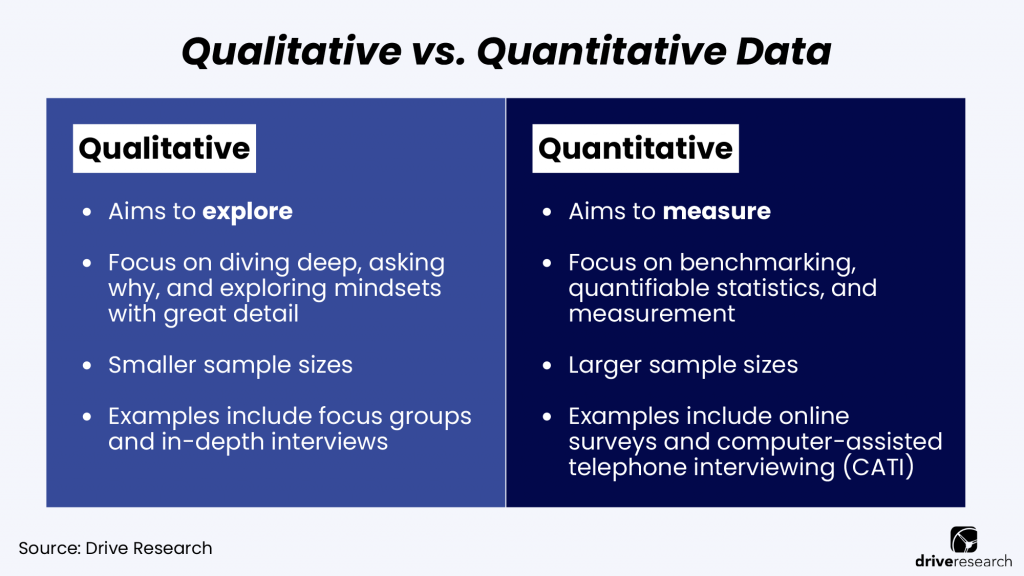
Asking better questions, utilizing appropriate methodologies, and implementing efficient techniques for your desired outcome are among the several factors that distinguish successful market research.
One effective approach to achieve this is through mixed-method research.
Mixed-mode data collection is a term used when multiple methodologies are used to collect data for a single project.
This may involve focus groups prior to a quantitative online survey. Or in-depth interviews (IDIs) to gather more feedback after a short online survey.
As long as multiple methodologies are used, it is referred to as mixed-method market research.
So why is it crucial to integrate it into your project strategy? And what is an example of mixed method research? We explore these common questions below.
What Is Mixed Method Research?
Mixed method market research refers to the use of more than one data collection method to gather information from research participants. It is also referred to as hybrid market research, mixed-mode research, and multimethodology research.
This approach allows a mixed-mode market research company such as Drive Research to gather both numerical data (quantitative) and descriptive data (qualitative), which can then be analyzed and synthesized to draw more robust and nuanced conclusions.
- Qualitative research methods such as focus groups, ethnographic observation, or in-depth interviews (IDIs) help to gather in-depth insights into consumer attitudes, behaviors, and motivations.
- Quantitative research methods, on the other hand, typically involve the collection of numerical data through online surveys or experiments.
Therefore, in mixed-method research, qualitative and quantitative methods are often used in combination.
Recommended Reading: What is the Difference Between Qualitative and Quantitative Market Research?

Why is Mixed-Mode Research Better?
Indeed, most research questions cannot be fully answered by a single research method. That’s where the mixed method market research method comes into play.
For example, a market research study might begin with a type of qualitative research to gain insights into consumer attitudes and behaviors, which can then help to inform the design of a quantitative survey.
The survey can then be administered to a larger sample of consumers, allowing researchers to analyze this data through statistical methods to identify patterns and relationships between variables.
Mixed methods draw on the benefits of each type of research such as:
1. Complementary strengths
By combining quantitative and qualitative research methods, mixed research can capitalize on the complementary strengths of each method.
That’s because, common forms of quantitative research are good at providing statistical data and generalizability, while qualitative methods are useful for understanding the context and complexity of human behavior.
Therefore, mixed-method research can provide a more comprehensive understanding of a research question than either method could alone.
We all know that different data collection methods have strengths and weaknesses, and combining them can help mitigate those shortcomings and improve the quality of data collected.
2. Triangulation
Mixed-method research also allows for triangulation, which is the use of multiple sources of data to confirm or refute research findings. By using several data sources, you can increase the validity and reliability of your results.
Triangulation can also help identify inconsistencies or contradictions in the data, which can be addressed through further investigation.
3. Flexibility
Mixed-method research is more flexible than using a single method of research. You can adapt your approach to fit the needs of the research question and the data collected.
For example, if the data collected using quantitative methods are not providing enough information, you can use qualitative methods to provide more context and detail.
This flexibility can help you get a more accurate and complete picture of your research question.
4. Contextualize online survey metrics
Mixed-mode market research can also involve using qualitative data to help interpret and contextualize the results of quantitative analysis.
For example, if a survey reveals that a large proportion of consumers prefer a particular product feature, researchers can use qualitative data to gain a deeper understanding of why consumers value that feature and what it means to them.
5. Increased response rates
Mixed-mode research can help increase survey response rates as participants can choose the data collection method that suits them best.
Respondents may prefer online surveys to telephone interviews or face-to-face interviews, and giving them the option to choose can lead to a higher response rate.
6. Better reach
Combining different data collection methods helps you to reach a wider audience. Not everyone has access to the Internet, and some may prefer to communicate via telephone or in person.
Combining different methods ensures that everyone can participate in the research, leading to a more diverse and representative sample.
What is an Example of Mixed Method Research?
Each type of research methodology depends on your project objectives.
However, a hybrid research approach allows you to reach a large audience and collect individual and group feedback.
For example, let’s say a company wants to launch a new line of frozen pizzas.
To gather insights about consumer preferences and purchasing behavior, the company decided to employ a mixed-mode research approach that combines both online and in-person methods.
- Phase one – online survey: The company works with an online survey company to distribute it to a representative sample of consumers. The survey asked questions about pizza consumption habits, preferred toppings, and packaging preferences.
- Phase two – focus groups: The pizza brand also conducts in-person focus groups with a smaller group of consumers. In these focus groups, participants taste-tested different pizza flavors and provided feedback on taste, texture, and overall appeal. Additionally, the focus group company observed participants’ behavior when selecting frozen pizzas from a store shelf and asked questions about their decision-making process.
- Online communities: The frozen pizza company also created an online bulletin board where consumers shared their thoughts and opinions about frozen pizzas. The company continued using the platform for ongoing discussion and feedback, as well as a way to recruit participants for further research studies.
By using the above mixed-mode approach with a full-service market research company, the company gathered a more comprehensive understanding of consumer needs and behavior.
The online survey provided a large sample size and helped identify overarching trends, while the in-person or online focus groups allowed for a deeper dive into consumer preferences and behavior. The online community provided ongoing feedback and allowed the company to engage with consumers over a longer period.
The pizza brand was also able to make more informed decisions about product development and marketing strategies.
Final Thoughts
Mixed-method research provides several benefits that make it better than relying on a single type of research.
By using complementary strengths, triangulation, flexibility, increased response rates, and a wider reach, mixed-method research can provide a more comprehensive understanding of a research question and increase the validity and reliability of research findings.
Additionally, these benefits make mixed-mode market research an ideal approach for conducting consumer research or understanding target audiences.
Contact Our Full-Service Research Company
Drive Research is a full-service market research company. We offer a full range of quantitative and qualitative market research services to help our clients capture a more comprehensive range of data to help in decision-making.
Interested in working with our team? Contact us today.



